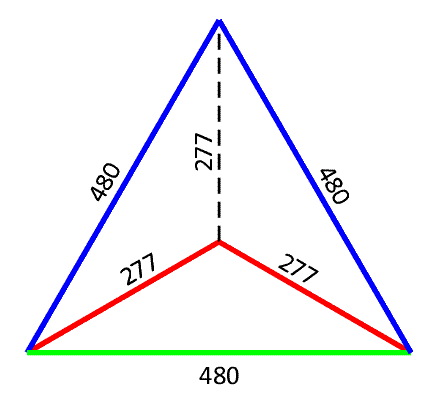You are using an out of date browser. It may not display this or other websites correctly.
You should upgrade or use an alternative browser.
You should upgrade or use an alternative browser.
480/277
- Thread starter jociha
- Start date
- Status
- Not open for further replies.
One way to see in it a real form is to drive a stake in the ground (call this "A") walk 277 feet and drive another stake at this location. (call this "B") Go back to the first stake ("A") and at walk another 277 feet at a 120 deg angle and drive a stake here. (call this "C") Measure from "C" to "B"
Roger
Roger
chris kennedy
Senior Member
- Location
- Miami Fla.
- Occupation
- 60 yr old tool twisting electrician
One way to see in it a real form is to drive a stake in the ground (call this "A") walk 277 feet and drive another stake at this location. (call this "B") Go back to the first stake ("A") and at walk another 277 feet at a 120 deg angle and drive a stake here. (call this "C") Measure from "C" to "B"
Roger
I think your first post nailed it.
LarryFine
Master Electrician Electric Contractor Richmond VA
- Location
- Henrico County, VA
- Occupation
- Electrical Contractor
John, in a single-phase system, one hot wire hits the peak + voltage (relative to the neutral) at the same time the other hot wire hits the peak - voltage, so the voltages add to twice one of them.
In 3-phase systems, one wire hits the + peak before another hits - peak and after the third hits - peak. Because the opposing peaks are offset in time, they add to less than two times one of them.
In 3-phase systems, one wire hits the + peak before another hits - peak and after the third hits - peak. Because the opposing peaks are offset in time, they add to less than two times one of them.
mdshunk
Senior Member
- Location
- Right here.
Does that work with 7,200? :grin:One way to see in it a real form is to drive a stake in the ground (call this "A") walk 277 feet and drive another stake at this location. (call this "B") Go back to the first stake ("A") and at walk another 277 feet at a 120 deg angle and drive a stake here. (call this "C") Measure from "C" to "B"
Roger
peter d
Senior Member
- Location
- New England
Does that work with 7,200? :grin:
Only if you need to lose weight.
JohnJ0906
Senior Member
- Location
- Baltimore, MD
Does that work with 7,200? :grin:
Give it a try, and let us all know.... :wink:
- Location
- Massachusetts
Does that work with 7,200? :grin:
You might want to switch to millimeters.
- Location
- New Jersey
- Occupation
- Journeyman Electrician (retired)
If you had an isosceles triangle with two sides equaling 1 and separated by 120 degrees your missing side would be equal to the square root of 3 or 1.73.
Does that work with 7,200? :grin:
If you have enough time and a big enough yard.
Roger
- Location
- Massachusetts
If you had an isosceles triangle with two sides equaling 1 and separated by 120 degrees your missing side would be equal to the square root of 3 or 1.73.
I think it has to be an equilateral triangle, an isosceles triangle may have only two equal sides which throws off the angles.
- Location
- Wisconsin
- Occupation
- PE (Retired) - Power Systems
I think it has to be an equilateral triangle, an isosceles triangle may have only two equal sides which throws off the angles.
2 legs from a delta configuration which is an equilateral triangle are different than the 2 legs from a wye configuration which form an isosceles triangle.
ceb58
Senior Member
- Location
- Raeford, NC
One way to see in it a real form is to drive a stake in the ground (call this "A") walk 277 feet and drive another stake at this location. (call this "B") Go back to the first stake ("A") and at walk another 277 feet at a 120 deg angle and drive a stake here. (call this "C") Measure from "C" to "B"
Roger
Roger just wants you to come drive the stakes for his new tractor shed
- Location
- New Jersey
- Occupation
- Journeyman Electrician (retired)
I think it has to be an equilateral triangle, an isosceles triangle may have only two equal sides which throws off the angles.
An equilateral will have all three sides the same therefore the angles would all have to be 60 degrees. An isosceles will have two sides the same which would allow one angle to be 120 degrees.
Roger just wants you to come drive the stakes for his new tractor shed
Shhhhhhhh.
Roger
- Location
- Massachusetts
An equilateral will have all three sides the same therefore the angles would all have to be 60 degrees. An isosceles will have two sides the same which would allow one angle to be 120 degrees.
I'm lost but I will take your word for it.
I'm lost but I will take your word for it.
You guys are talking about two different triangles... infinity - red... iwire - blue... but both your triangles have a common side - green.

.
- Status
- Not open for further replies.

